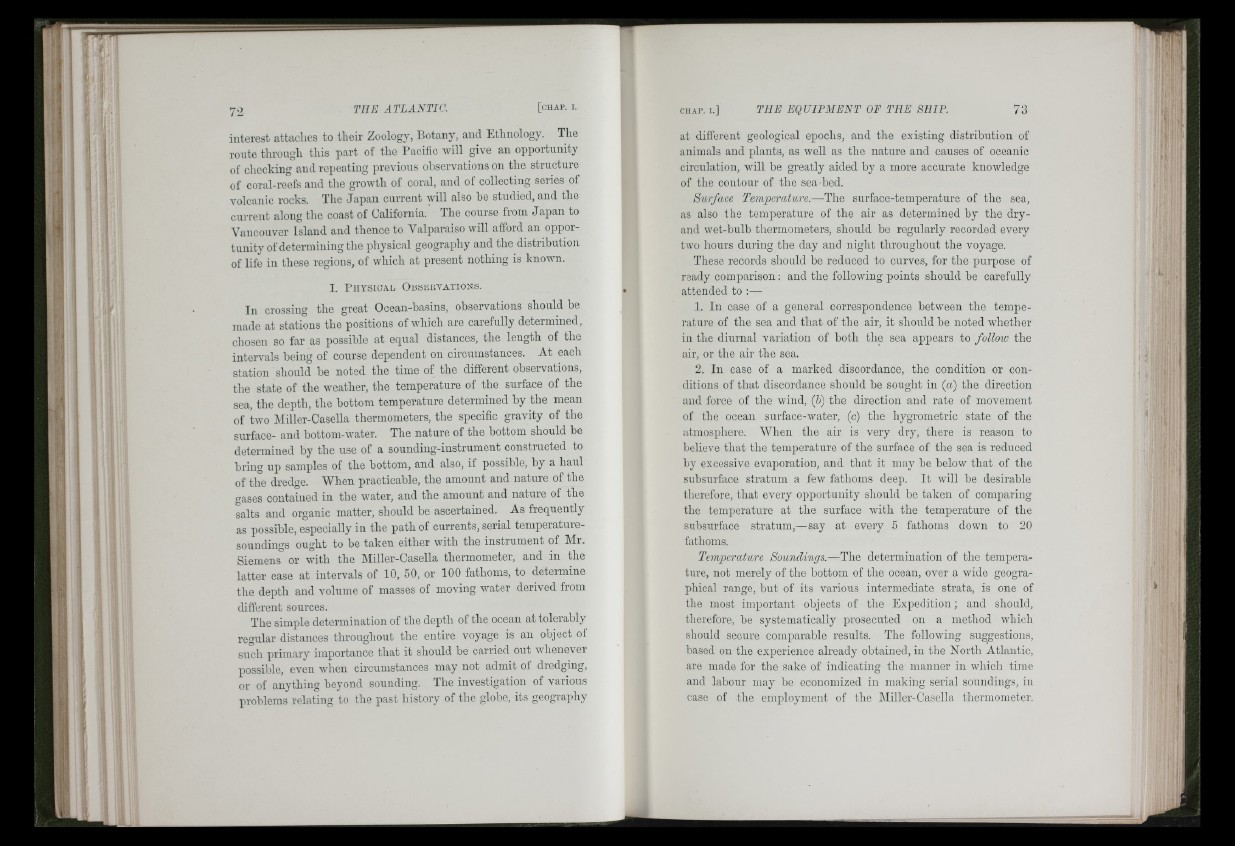
72
interest attaches to their Zoology, Botany, and Ethnology. The
route through this part of the Bacific will give an opportunity
of cliecking and repeating previous ohservations on the structure
of coral-reefs and the growth of coral, and of collecting series of
volcanic rocks. The Japan current will also be studied, and the
current along the coast of California. The course from Japan to
Vancouver Island and thence to Valparaiso wiil afford an opportunity
of determining tlie physical geography and the distribution
of life in these regions, of whicli at present nothing is known.
I. P hysical Obseua’Ations.
In crossing the great Ocean-basins, observations should be
made at stations the positions of Avhich are carefully determined,
chosen so far as possible at equal distances, the length of the
intervals being of course dependent on circumstances. At each
station should he noted the time of the different ohservations,
tlie state of the weather, the temperature of the surface of the
sea, the depth, tlie bottom temperature determined by the mean
of tAvo Miller-Casella thermometers, the specific gravity of the
surface- and bottom-Avater. The nature of the hottom should be
determined by the use of a soundiiig-mstrument constructed to
bring up samples of the bottom, and also, if possible, by a haul
of the dredge. When practicable, the amount and nature of the
gases contained in the Avater, and the amount and nature of the
L lts and organic matter, should be ascertained. As frequently
as possible, especially in the path of currents, serial teniperature-
soundings ought to be taken either with the instrument of Mr.
Siemens or Avith the Miller-Casella thermometer, and in the
latter case at intervals of 10, 50, or 100 fathoms, to determine
the depth and volume of masses of moving water derived from
different sources.
The simple determination of the depth of the ocean at tolerably
regular distances througiiont the entire voyage is an object of
snch primary importance that it should be carried out whenever
possible, even when circumstances may not admit of dredging,
or of anything beyond sounding. The investigation of various
problems relating to the past history of the globe, its geography
at different geological epochs, and tlie existing distribution of
animals and plants, as well as the nature and causes of oceanic
circulation, Avill be greatly aided by a more accurate knowledge
of the contour of the sea-bed.
Siorface Temperature.—The snrface-temperature of the sea,
as also the temperature of the air as determined by the dry-
and wet-bulb thermometers, should be regularly recorded eA’ery
two hours during the day and night throughout the A-'oyage.
These records slioiiid be reduced to curves, for the purpose of
ready comparison : and the following points should be carefully
attended to :■—
1. In case of a general correspondence between the temperature
of the sea and tliat of the air, it should be noted whether
in the diurnal variation of both tlie sea appears to follow the
air, or the air the sea.
2. In case of a marked discordance, the condition or conditions
of that discordance should be sought in {a) the direction
and force of the wind, (h) the direction and rate of movement
of the ocean surface-water, (c) the liygrometric state of the
atmosphere. 'When the air is very dry, there is reason to
helieve that the temperature of the surface of the sea is reduced
hy excessive evaporation, and that it may be below that of the
subsurface stratum a fcAV fathoms deep. I t will be desirable
therefore, that every opportunity sliould be taken of comparing
the temperature at tlie surface with the temperature of the
subsurface stratum,—say at every 5 fathoms down to 20
fathoms.
Temperature Soundings.—The determination of the temperature,
not merely of the bottom of the ocean, over a wide geogra-
pliicai range, but of its various intermediate strata, is one of
the most important objects of the Expedition ; and should,
tlierefore, be systematically prosecuted on a method A v h ic h
should secure comparable results. The following suggestions,
based on the experience already obtained, in the North Atlantic,
are made for the sake of indicating the manner in whicli time
and labour may be economized in making serial soundings, in
case of the employment of the Milier-Casella thermometer.